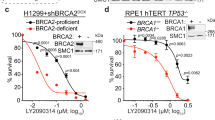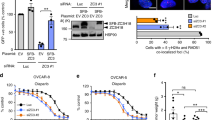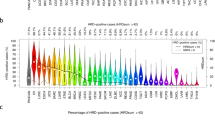Abstract
Interest has recently reawakened in whether loss of the heterochromatic X chromosome (Barr body) is prevalent in certain breast and ovarian cancers, and new insights into the mechanisms involved have emerged. Mitotic segregation errors commonly explain the loss of the inactive X chromosome (Xi), but compromise of Xi heterochromatin in some cancers may signal broader deficits of nuclear heterochromatin. The debated link between BRCA1 and Xi might reflect a general relationship between BRCA1 and heterochromatin, which could connect BRCA1 to both epigenetic and genetic instability. We suggest that heterochromatic instability is a common but largely unexplored mechanism, leading to widespread genomic misregulation and the evolution of some cancers.
This is a preview of subscription content, access via your institution
Access options
Subscribe to this journal
Receive 12 print issues and online access
$209.00 per year
only $17.42 per issue
Buy this article
- Purchase on Springer Link
- Instant access to full article PDF
Prices may be subject to local taxes which are calculated during checkout



Similar content being viewed by others

References
Barr, M. L. & Moore, K. L. Chromosomes, sex chromatin, and cancer. Proc. Can. Cancer Conf. 2, 3–16 (1957).
Hall, L. L. & Lawrence, J. B. The cell biology of a novel chromosomal RNA: chromosome painting by XIST/Xist RNA initiates a remodeling cascade. Semin. Cell Dev. Biol. 14, 369–378 (2003).
Cohen, D. E. & Lee, J. T. X-chromosome inactivation and the search for chromosome-wide silencers. Curr. Opin. Genet. Dev. 12, 219–224 (2002).
Heard, E. & Disteche, C. M. Dosage compensation in mammals: fine-tuning the expression of the X chromosome. Genes Dev. 20, 1848–1867 (2006).
Chow, J. C., Yen, Z., Ziesche, S. M. & Brown, C. J. Silencing of the mammalian X chromosome. Annu. Rev. Genomics Hum. Genet. 6, 69–92 (2005).
Marahrens, Y., Panning, B., Dausman, J., Strauss, W. & Jaenisch, R. Xist deficient mice are defective in dosage compensation but not spermatogenesis. Genes Dev. 11, 156–166 (1997).
Lengauer, C., Kinzler, K. W. & Vogelstein, B. Genetic instability in colorectal cancers. Nature 386, 623–627 (1997).
Draviam, V. M., Xie, S. & Sorger, P. K. Chromosome segregation and genomic stability. Curr. Opin. Genet. Dev. 14, 120–125 (2004).
Spatz, A., Borg, C. & Feunteun, J. X-chromosome genetics and human cancer. Nature Rev. Cancer 4, 617–629 (2004).
Ganesan, S. et al. BRCA1 supports XIST RNA concentration on the inactive X chromosome. Cell 111, 393–405 (2002).
Pageau, G. J., Hall, L. L. & Lawrence, J. B. BRCA1 does not paint the inactive X chromosome to localize XIST RNA but may contribute to broad changes in cancer that impact XIST and Xi heterochromatin. J. Cell. Biochem. 100, 835–850 (2007).
Xiao, C. et al. The XIST noncoding RNA functions independently of BRCA1 in X inactivation. Cell 128, 977–989 (2007).
Silver, D. P. et al. Further evidence for BRCA1 communication with the inactive X chromosome. Cell 128, 991–1002 (2007).
Rosen, P. P. et al. Barr body distribution and estrogen receptor protein in mammary carcinoma. Ann. Clin. Lab. Sci. 7, 491–499 (1977).
Smethurst, M. et al. Steroid hormone receptors and sex chromatin frequency in breast cancer. J. Endocrinol. Invest. 4, 455–457 (1981).
Perry, M. Evaluation of breast tumour sex chromatin (Barr body) as an index of survival and response to pituitary ablation. Br. J. Surg. 59, 731–734 (1972).
Hultborn, R. et al. Prevalence of Klinefelter's syndrome in male breast cancer patients. Anticancer Res. 17, 4293–4297 (1997).
Swerdlow, A. J. et al. Mortality and cancer incidence in persons with numerical sex chromosome abnormalities: a cohort study. Ann. Hum. Genet. 65, 177–188 (2001).
Swerdlow, A. J., Schoemaker, M. J., Higgins, C. D., Wright, A. F. & Jacobs, P. A. Mortality and cancer incidence in women with extra X chromosomes: a cohort study in Britain. Hum. Genet. 118, 255–260 (2005).
Kawakami, T. et al. Characterization of loss-of-inactive X in Klinefelter syndrome and female-derived cancer cells. Oncogene 23, 6163–6169 (2004).
Sirchia, S. M. et al. Loss of the inactive X chromosome and replication of the active X in BRCA1-defective and wild-type breast cancer cells. Cancer Res. 65, 2139–2146 (2005).
Richardson, A. L. et al. X chromosomal abnormalities in basal-like human breast cancer. Cancer Cell 9, 121–132 (2006).
Benoit, M. H. et al. Global analysis of chromosome X gene expression in primary cultures of normal ovarian surface epithelial cells and epithelial ovarian cancer cell lines. Int. J. Oncol. 30, 5–17 (2007).
Jazaeri, A. A. et al. Gene expression profiles of BRCA1-linked, BRCA2-linked, and sporadic ovarian cancers. J. Natl Cancer Inst. 94, 990–1000 (2002).
Jazaeri, A. A. et al. BRCA1-mediated repression of select X chromosome genes. J. Transl. Med. 2, 32 (2004).
Lakhani, S. R. et al. Prediction of BRCA1 status in patients with breast cancer using estrogen receptor and basal phenotype. Clin. Cancer Res. 11, 5175–5180 (2005).
Sorlie, T. et al. Repeated observation of breast tumor subtypes in independent gene expression data sets. Proc. Natl Acad. Sci. USA 100, 8418–8423 (2003).
Carrel, L. & Willard, H. F. X-inactivation profile reveals extensive variability in X-linked gene expression in females. Nature 434, 400–404 (2005).
Clemson, C. M., Hall, L. L., Byron, M., McNeil, J. & Lawrence, J. B. The X chromosome is organized into a gene-rich outer rim and an internal core containing silenced nongenic sequences. Proc. Natl Acad. Sci. USA 103, 7688–7693 (2006).
Bailey, J. A., Carrel, L., Chakravarti, A. & Eichler, E. E. Molecular evidence for a relationship between LINE-1 elements and X chromosome inactivation: the Lyon repeat hypothesis. Proc. Natl Acad. Sci. USA 97, 6634–6639 (2000).
Carrel, L. et al. Genomic environment predicts expression patterns on the human inactive X chromosome. PLoS Genet. 2, e151 (2006).
Wang, Z., Willard, H. F., Mukherjee, S. & Furey, T. S. Evidence of influence of genomic DNA sequence on human X chromosome inactivation. PLoS Comput. Biol. 2, e113 (2006).
Feinberg, A. P. & Tycko, B. The history of cancer epigenetics. Nature Rev. Cancer 4, 143–153 (2004).
Csankovszki, G., Nagy, A. & Jaenisch, R. Synergism of Xist RNA, DNA methylation, and histone hypoacetylation in maintaining X chromosome inactivation. J. Cell Biol. 153, 773–783 (2001).
Hakem, R. et al. The tumor suppressor gene Brca1 is required for embryonic cellular proliferation in the mouse. Cell 85, 1009–1023 (1996).
Narod, S. et al. Increasing incidence of breast cancer in family with BRCA1 mutation. Lancet 341, 1101–1102 (1993).
Diaz-Perez, S. V. et al. A deletion at the mouse Xist gene exposes trans-effects that alter the heterochromatin of the inactive X chromosome and the replication time and DNA stability of both X chromosomes. Genetics 174, 1115–1133 (2006).
Starita, L. M. et al. BRCA1-dependent ubiquitination of γ-tubulin regulates centrosome number. Mol. Cell Biol. 24, 8457–8466 (2004).
Joukov, V. et al. The BRCA1/BARD1 heterodimer modulates ran-dependent mitotic spindle assembly. Cell 127, 539–552 (2006).
Scully, R. et al. Association of BRCA1 with Rad51 in mitotic and meiotic cells. Cell 88, 265–275 (1997).
Turner, J. M. et al. BRCA1, histone H2AX phosphorylation, and male meiotic sex chromosome inactivation. Curr. Biol. 14, 2135–2142 (2004).
Brown, C. J. et al. The Human XIST gene: analysis of a 17 kb inactive X-specific RNA that contains conserved repeats and is highly localized within the nucleus. Cell 71, 527–542 (1992).
Brockdorff, N. et al. The product of the mouse Xist gene is a 15 kb inactive X-specific transcript containing no conserved ORF and located in the nucleus. Cell 71, 515–526 (1992).
Clemson, C. M., McNeil, J. A., Willard, H. F. & Lawrence, J. B. XIST RNA paints the inactive X chromosome at interphase: evidence for a novel RNA involved in nuclear/chromosome structure. J. Cell Biol. 132, 259–275 (1996).
Pageau, G. J. & Lawrence, J. B. BRCA1 foci in normal S-phase nuclei are linked to interphase centromeres and replication of pericentromeric heterochromatin. J. Cell Biol. 175, 693–701 (2006).
Vincent-Salomon, A. et al. X inactive-specific transcript RNA coating and genetic instability of the X chromosome in BRCA1 breast tumors Cancer Res. 67, 5134–5140 (2007).
Welcsh, P. L. et al. BRCA1 transcriptionally regulates genes involved in breast tumorigenesis. Proc. Natl Acad. Sci. USA 99, 7560–7565 (2002).
Peters, A. H. et al. Loss of the Suv39h histone methyltransferases impairs mammalian heterochromatin and genome stability. Cell 107, 323–337 (2001).
Feinberg, A. P. & Vogelstein, B. Hypomethylation distinguishes genes of some human cancers from their normal counterparts. Nature 301, 89–92 (1983).
Zink, D., Fischer, A. H. & Nickerson, J. A. Nuclear structure in cancer cells. Nature Rev. Cancer 4, 677–687 (2004).
Gonzalo, S. et al. Role of the RB1 family in stabilizing histone methylation at constitutive heterochromatin. Nature Cell Biol. 7, 420–428 (2005).
Chadwick, B. P. & Willard, H. F. Chromatin of the Barr body: histone and non-histone proteins associated with or excluded from the inactive X chromosome. Hum. Mol. Genet. 12, 2167–2178 (2003).
Norwood, L. E. et al. A requirement for dimerization of HP1Hsα in suppression of breast cancer invasion. J. Biol. Chem. 281, 18668–18676 (2006).
Bochar, D. A. et al. BRCA1 is associated with a human SWI/SNF-related complex: linking chromatin remodeling to breast cancer. Cell 102, 257–265 (2000).
Ye, Q. et al. BRCA1-induced large-scale chromatin unfolding and allele-specific effects of cancer-predisposing mutations. J. Cell Biol. 155, 911–921 (2001).
Esteller, M. Aberrant DNA methylation as a cancer-inducing mechanism. Annu. Rev. Pharmacol. Toxicol. 45, 629–656 (2005).
Disteche, C. M. Escape from X inactivation in human and mouse. Trends Genet. 11, 17–22 (1995).
Miller, A. P. & Willard, H. F. Chromosomal basis of X chromosome inactivation: identification of a multigene domain in Xp11.21-p11.22 that escapes X inactivation. Proc. Natl Acad. Sci. USA 95, 8709–8714 (1998).
Frigola, J. et al. Epigenetic remodeling in colorectal cancer results in coordinate gene suppression across an entire chromosome band. Nature Genet. 38, 540–549 (2006).
Tam, R., Smith, K. P. & Lawrence, J. B. The 4q subtelomere harboring the FSHD locus is specifically anchored with peripheral heterochromatin unlike most human telomeres. J. Cell Biol. 167, 269–279 (2004).
Hall, L. L. et al. An ectopic human XIST gene can induce chromosome inactivation in postdifferentiation human HT-1080 cells. Proc. Natl Acad. Sci. USA 99, 8677–8682 (2002).
Acknowledgements
The authors are funded by grants from the US National Institutes of Health and a Department of Defense predoctoral research fellowship (G.J.P.).
Author information
Authors and Affiliations
Corresponding authors
Ethics declarations
Competing interests
The authors declare no competing financial interests.
Related links
Related links
DATABASES
National Cancer Institute
FURTHER INFORMATION
Rights and permissions
About this article
Cite this article
Pageau, G., Hall, L., Ganesan, S. et al. The disappearing Barr body in breast and ovarian cancers. Nat Rev Cancer 7, 628–633 (2007). https://doi.org/10.1038/nrc2172
Published:
Issue Date:
DOI: https://doi.org/10.1038/nrc2172


